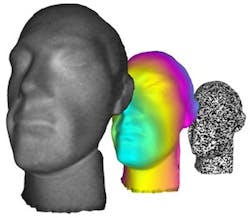University of Glasgow scientists create 3D images with single-pixel detector
Glasgow, Scotland--A group at the University of Glasgow has created a single-pixel imaging setup that captures 3D images. The device, which actually uses four single-pixel photodetectors, has the potential to greatly simplify 3D imaging.
“Single-pixel detectors in four different locations are used to detect light from a data projector, which illuminates objects with a rapidly shifting sequence of black-and-white patterns similar to crossword puzzles," explains Miles Padgett, a professor at the university and one of the researchers. "When more of the white squares of these patterns overlap with the object, the intensity of the light reflected back to the detectors is higher. A series of projected patterns and the reflected intensities are used in a computer algorithm to produce a 2D image." He adds that the data from the four images is combined using a well-known technique known as "shape from shade" to create a full 3D image.
Related: Lensless ghost imaging uses true thermal light
Related: Compressive sensing architecture advances infrared camera design
“Conventional 3D imaging systems which use multiple digital camera sensors to produce a 3D image from 2D information need to be carefully calibrated to ensure the multi-megapixel images align correctly," says Padgett. "Our single-pixel system creates images with a similar degree of accuracy without the need for such detailed calibration.”
The technique the team uses is called 3D computational imaging, or "ghost" imaging, and the system they have created can produce detailed images of objects in just a few seconds. One of the primary benefits of using the new technique over more conventional 3D imaging techniques is that there exist single-pixel detectors that can detect wavelengths far beyond those digital cameras are currently capable of, such as terahertz radiation.
“A more-portable version of the system could be created quite easily, making it much more practical to use outside the lab," says research assistant Matthew Edgar. "It could be used to look for the telltale gases which leak from the ground where oil can be found, for example, or it could be tuned into the terahertz range to probe just below the skin to search for tumors or other medical conditions. We plan to continue working on the system and perhaps working with commercial partners to bring a version to market in the future.”
The team’s paper, "3D Computational Imaging with Single-Pixel Detectors," is published in Science.

John Wallace | Senior Technical Editor (1998-2022)
John Wallace was with Laser Focus World for nearly 25 years, retiring in late June 2022. He obtained a bachelor's degree in mechanical engineering and physics at Rutgers University and a master's in optical engineering at the University of Rochester. Before becoming an editor, John worked as an engineer at RCA, Exxon, Eastman Kodak, and GCA Corporation.
